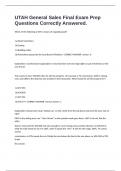UTAH General Sales Final Exam Prep
Questions Correctly Answered.
Which of the following is NOT a means of regulating land?
(a) Deed restrictions
(b) Zoning
(c) Building codes
(d) Resolutions passed by the local Board of Realtors - CORRECT ANSWER answer: d
Explanation: A professional organization of any kind does not have legal rights to put restrictions on the
use of land.
Tom wants to clear $90,000 when he sells his property. He must pay a 7% commission, $250 in closing
cost, and $300 to the attorney who assisted in the transaction. What should he sell the property for?
(a) $97,365
(b) $96,850
(c) $97,324
(d) $96,774 - CORRECT ANSWER Correct answer: a
Explanation: Always have to go "bottom up" on this. Work from the top down and you'll be close, but no
cigar!
FIRST is the selling price, our "I don't know" so the question mark goes there. LAST is the net. But the
seller
doesn't only need the $90,000, but also enough to cover closing costs and the attorney. So $90,550 is
what he really needs to net. For LAST, what % equals the "net?" It sells for the magic 100%, 7% comes
out for
commission, so 93% equals the net. Divide the one below the line by the one above, or $90,550 by 93%
to get
the answer.
,Tim gets a 80% loan on a $100,000 property and is charged a 1 point origination fee. He is also charged a
$35
credit report fee and a $450 appraisal. How much must Tim come to settlement with to then close the
deal?
(a) $1,485
(b) $21, 285
(c) $100,485
(d) $1,285 - CORRECT ANSWER answer: b
Explanation: Tim gets a $80K loan ($100K * 80%) and is charged 1 point or 1% ($800). Add the down
payment,
origination fee, credit report fee, and appraisal fee: $20,000 + $800 + $35 + $450 = $21,285
Which of the following is NOT one of the essential elements of value?
(a) Highest and best use
(b) Demand
(c) Scarcity
(d) Transferability - CORRECT ANSWER answer: a
Explanation: DUST -- Highest and best use does not fit with the initials! Highest and best use is the first
principle
of appraising.
In which of the following situations involving a 1031 would income taxes NOT have to be paid?
(a) The exchange of two properties resulting in one owner owing $5,000 less than before on the
property loan.
,(b) Exchanging a duplex and a car for a triplex
(c) The exchange of a fourplex in the city for a small farm of equal value.
(d) The exchange of a boat which can be a residence for a single family home. - CORRECT ANSWER
answer: c
Explanation: (Taxation) The 1031 applies to "like for like" or real property for real property. Personal
property
involved would be taxable and mortgage or debt relief is taxable.
A property description that uses angles and degrees is referred to as:
(a) Metes and bounds
(b) Government survey
(c) Lot, block, and plat
(d) An informal description - CORRECT ANSWER answer: a
Explanation: A street address is an example of an informal description. The other three answers are the
correct
names of the three methods for legal descriptions.
A property had a net operating income of $3,430. If the property had a value of $22,000, what was the
rate of
return of this property?
(a) 0.16%
(b) 15.59%
(c) 1.56%
(d) 6.41% - CORRECT ANSWER answer: b
, Explanation: This is a cap rate, capitalization, or rate of return question. FIRST = Value (Falue); RATE =
rate of
return; LAST = NOI (remember it must be an annual number). We have the value at the top, the NOI at
the
bottom, so we divide the one below the line by the one above the line.
The appraiser was determing the value of the property based on the cost approach. The outside
dimensions of
the home were 28' x 40' and the cost was $11.25 per square foot. His estimate of value was:
(a) $126,000.00
(b) $12,600.00
(c) $1,530.00
(d) $765.00 - CORRECT ANSWER answer: b
Explanation: o get the number of square feet, multiply length times width. Then merely multiply the
total square
feet by the cost per square foot.
A lender, as security for a loan, has the right to force the sale of the property to recover the amount
owed. But if more than the loan and costs amount is recovered, the excess goes back to the borrower.
This is:
(a) Hypothecation theory
(b) Mortgage theory
(c) Lien theory
(d) Title theory - CORRECT ANSWER Correct answer: c
Explanation: (Mortgage Law) In title theory states the lender owns the property, therefore would be
entitled to any profits. In lien theory, the lender is entitled to loan payoff (and costs of foreclosure), but
any profits are the
defaulting borrowers.




